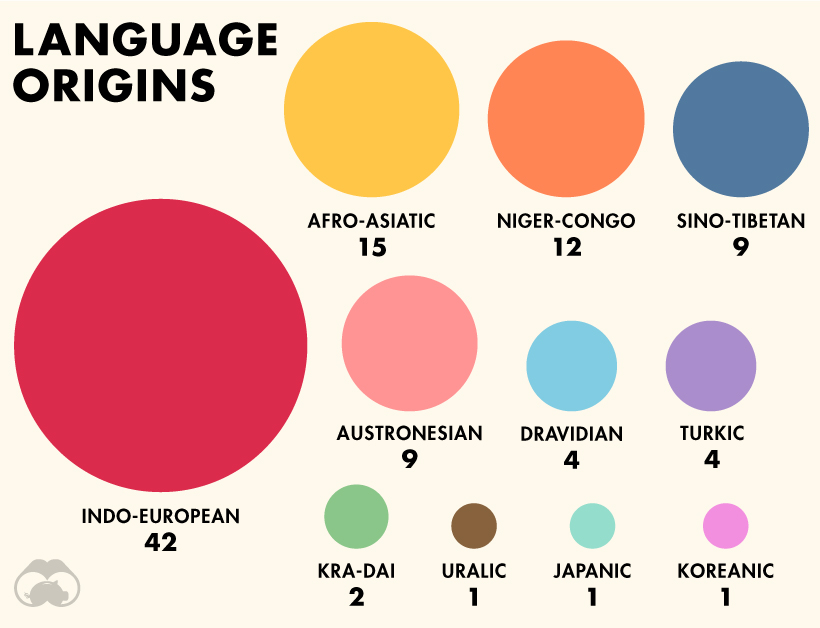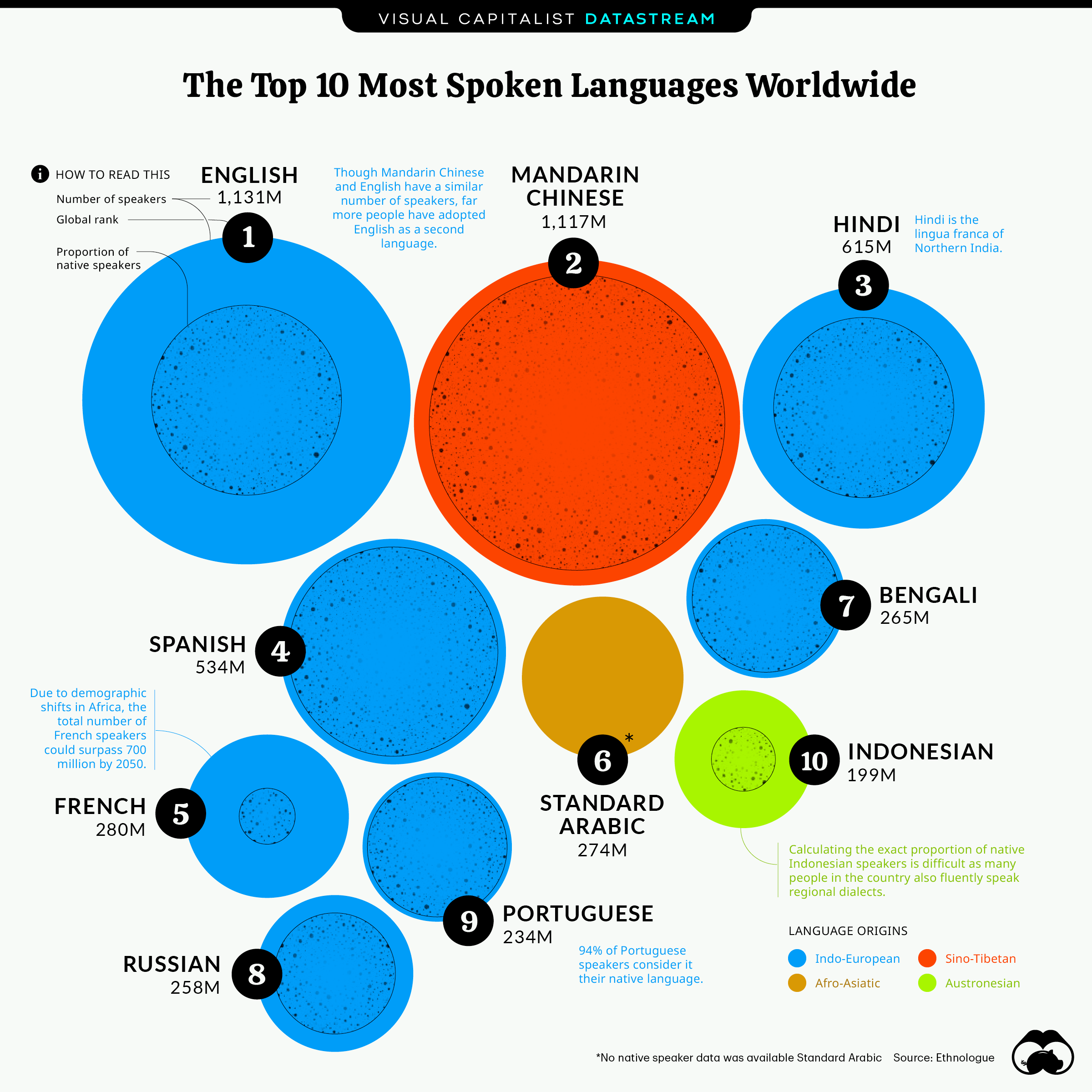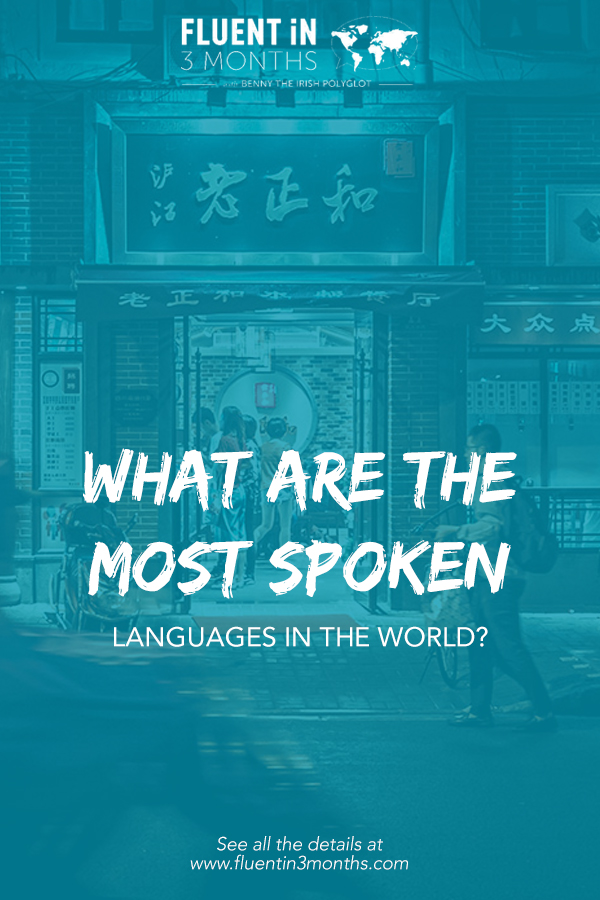What the world s most spoken languages are
What the world s most spoken languages are
The 12 most spoken languages in the world

Well, more than 7,100 languages are spoken in the world today. Each and every one of them make the world a diverse and beautiful place.
Others are spoken by huge populations across different countries, and are often popular choices among language learners.
The top 12 most spoken languages in the world
1. English (1,132 million speakers)
Language family: Germanic, a sub-family of Indo-European
Related to: German, Dutch, Frisian
Fun fact: The English word “goodbye” was originally a contraction of “God be with ye”.
With over 1,130 million native speakers, English is the most spoken language in the world.
It’s also the official language of the sky – all pilots have to speak and identify themselves in English.
Not only is Shakespeare widely considered as one of the greatest dramatists of all time, but over his lifespan he added an incredible amount of about 1,700 words to the English language by changing nouns into verbs, verbs into nouns, connecting some words with each other and adding prefixes or suffixes to others.
2. Mandarin Chinese (1,117 million speakers)
Language family: Sino-Tibetan
Related to: Cantonese, Tibetan, Burmese
Fun fact: Research suggests that you’ll only need around 2,500 characters to be able to read almost 98 percent of everyday written Chinese.
In terms of native speakers alone, Mandarin Chinese is by far the second most spoken language in the world.
It’s an official language of mainland China, Taiwan and Singapore and one of the six official languages of the United Nations. So it’s not surprising that there are approximately 1.09 million native speakers worldwide.
Mandarin is a tonal language, which means that the meaning of a word changes based on the way we pronounce it.
With a set of about 50,000 characters, it is probably one of the most complex languages to learn.
But don’t worry: there are no verb conjugations, no tenses and no gender-specific nouns either.
Quite motivating, isn’t it?
Maybe that’s also why it’s one of the most popular languages to learn today…
3. Hindi (615 million speakers)
Language family: Indo-Ayran, a sub-family of Indo-European
Related to: Bengali, Punjabi, Marathi, Kashmiri, Nepali
Fun fact: If you’re an English speaker, you probably already know some Hindi. Do words like ‘guru’, ‘jungle’, ‘karma’, ‘yoga’, ‘bungalow’, ‘cheetah’ and ‘avatar’ ring a bell? These words (and many more!) have been borrowed from Hindi.
There are about 615 million native Hindi speakers, which makes it the third most spoken language in the world. It’s the official language of India, and is also spoken in countries such as Nepal, Fiji, Mauritius and Guyana.
4. Spanish (534 million speakers)
Language family: Romance, a sub-family of Indo-European
Related to: French, Italian, Portuguese, Romanian
Fun fact: The first modern novel and the second most translated book after the Bible was written in Spanish. Which novel? It’s Don Quixote by Miguel de Cervantes, of course!
Twenty-two countries over four continents have Spanish as the or one of the official languages, and it’s already the second most studied language in the world.
Can you believe that within three generations, 10 percent of the world’s population will be able to communicate in Spanish?
This is great news for native English speakers.
5. French (280 million speakers)
Language family: Romance
Related to: Spanish, Italian, Portuguese, Romanian
Fun fact: About 45 per cent of modern English words are of French origin.
In spite of what Hollywood movies might tell you, the language of love doesn’t solely exist on moonlit walks in Paris.
Spoken across different parts of the world – think everywhere from the rest of France and parts of Canada to a handful of African countries, including Senegal and Madagascar – the French language has spread its roots far and wide.
6. Arabic (274 million speakers)
Language family: Semitic, a sub-family of Afro-Asiatic
Related to: Hebrew, Amharic, Aramaic
With 295 million native speakers, Arabic is the sixth most spoken language in the world, and the only one in our top twelve that is written from right to left.
It has also heavily influenced European languages like Spanish and Portuguese: some words sound exactly the same.
7. Bangla/Bengali (265 million speakers)
Language family: Indo-Aryan, a sub-family of Indo-European
Related to: Hindu, Punjabi, Marathi, Kashmiri, Nepali
Fun fact: While the Bengali script is relatively unknown in the West, but it’s actually the fifth most widely used writing system in the world!
Bengali, known to many English speakers around the world as Bangla, is mostly spoken in Bangladesh and India and is considered by some to be the second most beautiful language after French.
With around 205 million native speakers, it’s the seventh most spoken language in the world.
The Bengali alphabet is particularly interesting.
Every consonant has a vowel sound built in, which is quite unusual for Westerners.
It gets even better: different marks change the default vowel sound of a word and therefore also the meaning!
8. Russian (258 million speakers)
Language family: East Slavic, a sub-family of Indo-European
Related to: Ukrainian, Belarusian
Fun fact: Due to Russia’s presence in space technology, it is a requirement for foreign astronauts to know a certain amount of Russian (as if becoming an astronaut wasn’t already difficult enough!).
While Russian grammar is renowned to be a little tricky, Russian only has about 200,000 words (English has roughly one million), which is why most of them have more than one meaning.
9. Portuguese (234 million speakers)
Language family: Romance, a sub-branch of Indo-European
Related to: Spanish, French, Italian, Romanian
Fun fact: Until recently, the letters “k”, “w“ and “y” were not part of the Portuguese alphabet. In 2009, a new agreement was signed to standardise spelling forms across different variations.
Portuguese is rooted in the region of Medieval Galicia (which was partly in the north of Portugal and partly in the northwest of Spain), but only five percent of the 215 million native Portuguese speakers actually live in Portugal.
You probably know that it’s the official language of Brazil, but is also has the sole official status in: Angola, Mozambique, Guinea-Bissau, East Timor, Equatorial Guinea, Macau, Cape Verde, and São Tomé and Príncipe.
10. Indonesian (199 million speakers)
Language family: Austronesian
Related to: Malay, Javanese, Sundranese, Madurese etc.
Fun fact: Along with Malay, it’s up there in the list of most polite languages in the world’s Eastern region.
A standardised variation of Malay, an Austronesian language that’s the official language of Malaysia, Indonesian is a great example of a widely spoken language that encompasses a number of distinct dialects across Indonesia.
And despite Western preconceptions, with a simple structure and easy pronunciation in its favour, Indonesian is surprisingly easy to learn.
11. Urdu (170 million speakers)
Language family: Indo-Aryan
Related to: Hindi, Bengali, Marathi, Kashmiri, Nepali
Fun fact: Hindi and Urdu speakers can have a simple conversation just fine – provided they keep things relatively simple!
The lingua franca of Pakistan and very close to Hindi, Urdu has crept up on the most spoken languages list in the last year or so.
Dubbed by some as the language of love for its intriguing-sounding and beautiful words, the French language may have some competition on its hands…
12. German (132 million speakers)
Language family: West Germanic, a sub-family of Indo-European
Related to: English, Frisian, Dutch
Fun fact: German is known for its seemingly endless sentences.
Often referred to as the language of writers and thinkers, German has just over 100 million native – and just under 32 non-native – speakers worldwide, and is the most spoken language in the European Union.
It’s an official language of Germany, Austria, Liechtenstein, Switzerland and Luxembourg.
German is especially well known for its ability to create completely new and super specific words.
Feeling inspired to learn a new language?
We’re Busuu, an app that makes mastering a language easier for everyone. Start learning with us today.
The Most Spoken Languages in the World
Mandarin Chinese is the world’s most common first language.
The ten most spoken languages in the world are Mandarin, Spanish, English, Portuguese, Arabic, Hindi, Bengali, Russian, Japanese and Javanese. The ranking is according to the native speakers.
Most Spoken Languages By Native Speakers
Mandarin Chinese
Mandarin Chinese is the most spoken language in the world. The estimated population of Mandarin native speakers is 848 million. Mandarin is the official language in the People’s Republic of China, Taiwan, and Singapore. It is written using Chinese characters. There are two versions of the Chinese characters, namely the traditional characters and simplified characters. The traditional characters are currently used in Hong Kong, Taiwan, and Macau. On the other hand, Mandarin speakers in Malaysia, China, and Singapore use the simplified version.
Spanish
Spanish is the second most spoken language in the world in terms of native speakers. An estimated 329 million natives speak Spanish. Spanish in Spanish is known as “español.” The language originated in the Castile region of Spain. Therefore, one may sometimes hear the Spanish language referred to as “Castilian.” Spanish explorers were responsible for spreading the language to many parts of the world. In the US, Spanish is the second most spoken language which makes it the second biggest Spanish-speaking country after Mexico.
English
The word English came from the “Angles” people who settled in Britain in the first millennium AD. The Angles were Germans who derived their name from a place in northern Germany called “Anglen.” Many years later, the English native speakers are approximately 328 million. English spread to other parts of the world because of the historical dominance of the British Empire. British missionaries, explorers, and colonialists introduced English to many parts of the world. Today, English is popularly the world’s “lingua franca.”
Portuguese
There are approximately 250 million native Portuguese speakers in the world. The Portuguese language developed from Latin and is closely related to modern Spanish. A Portuguese speaker is known as a “Lusophone.” Most Portuguese speakers live in Brazil. However, Portuguese is the official language in nine countries including Macau which is Chinese territory.
Arabic
Arabic is a language spoken by close to 221 million native speakers. It originated from the Arabian Peninsula. Presently, it is spoken by people who live in the Middle East and North African countries who are predominantly Muslims. Arabic is the language of the Islamic religion; although most Muslims are not native Arabic speakers. Muslims believe that God dictated the Quran to their prophet Mohammed in Arabic. The “Classical Arabic” that existed then, about 1400 years ago, is quite different from the “Modern Standard Arabic” used by most Arabic speakers today.
The Significance of Languages
Language is an essential aspect of people’s culture. It defines their beliefs and gives them a distinct identity from the rest of the world. However, people are free to learn other languages besides their native languages for the sake of business, education, tourism, and many other reasons. The three most commonly spoken languages in the world are Mandarin, Spanish, and English.
Ranked: The 100 Most Spoken Languages Around the World
February 15, 2020
Ranked: The 100 Most Spoken Languages Worldwide
Even though you’re reading this article in English, there’s a good chance it might not be your mother tongue. Of the billion-strong English speakers in the world, only 33% consider it their native language.
The popularity of a language depends greatly on utility and geographic location. Additionally, how we measure the spread of world languages can vary greatly depending on whether you look at total speakers or native speakers.
Today’s detailed visualization from WordTips illustrates the 100 most spoken languages in the world, the number of native speakers for each language, and the origin tree that each language has branched out from.
How Do You Define A Language?
The data comes from the 22nd edition of Ethnologue, a database covering a majority of the world’s population, detailing approximately 7,111 living languages in existence today.
The definitions of languages are often dynamic, blurring the lines around a singular understanding of what makes a language:
For the purposes of measurement, the researchers use the ISO 693-3 set of criteria, which accounts for related varieties and dialects—ensuring that linguistics are not the only factor considered in this count of languages.
Here are the language origins of the 100 most spoken languages:
Indo-European languages have the widest spread worldwide. According to Ethnologue, the language family contains over 3 billion speakers in total. Interestingly, there are actually 1,526 Niger-Congo languages altogether, though only 12 are represented here.
Let’s now dive into the top 10 most spoken languages overall.
Which Languages Have the Most Speakers?
It comes as no surprise that English reigns supreme, with over 1.1 billion total speakers—or roughly 15% of the global population. Mandarin Chinese, Hindi, Spanish, and French round out the top five.
| Rank | Language | Total Speakers | Language Origin |
|---|---|---|---|
| 1 | English | 1,132 million | Indo-European |
| 2 | Mandarin Chinese | 1,117 million | Sino-Tibetan |
| 3 | Hindi | 615 million | Indo-European |
| 4 | Spanish | 534 million | Indo-European |
| 5 | French | 280 million | Indo-European |
| 6 | Standard Arabic | 274 million | Afro-Asiatic |
| 7 | Bengali | 265 million | Indo-European |
| 8 | Russian | 258 million | Indo-European |
| 9 | Portuguese | 234 million | Indo-European |
| 10 | Indonesian | 199 million | Austronesian |
However, this is only one piece in the full fabric of languages.
The metrics for native speakers tell a slightly different tale, as Mandarin Chinese shoots up to 918 million—almost 2.5x that of English native speakers.
| Rank | Language | Native Speakers | Language Origin |
|---|---|---|---|
| 1 | Mandarin Chinese | 918 million | Sino-Tibetan |
| 2 | Spanish | 460 million | Indo-European |
| 3 | English | 379 million | Indo-European |
| 4 | Hindi | 341 million | Indo-European |
| 5 | Bengali | 228 million | Indo-European |
| 6 | Portuguese | 221 million | Indo-European |
| 7 | Russian | 154 million | Indo-European |
| 8 | Japanese | 128 million | Japanic |
| 9 | Western Punjabi | 93 million | Indo-European |
| 10 | Marathi | 83 million | Indo-European |
Note: No native speaker data was available for Filipino, Standard Arabic, Nigerian Pidgin, or Cameroonian Pidgin.
Here, Spanish comes in strong second for native speakers with 460 million, considering it’s well-used across Latin America. The Indian languages of Hindi and Bengali cap off the top five by native speakers as well.
These are the biggest languages people learn growing up, but what about the ones they pick up later in life?
What About Second (L2) Languages?
Nearly 43% of the world’s population is bilingual, with the ability to switch between two languages with ease.
From the data, second language (L2) speakers can be calculated by looking at the difference between native and total speakers, as a proportion of the total. For example, 66% of English speakers learned it as a second language.
Swahili surprisingly has the highest ratio of L2 speakers to total speakers—although it only has 16 million native speakers, this shoots up to 98 million total speakers. Overall, 82% of Swahili speakers know it as a second language.
Swahili is listed as a national or official language in several African countries: Tanzania, Kenya, Uganda, and the Democratic Republic of Congo. It’s likely that the movement of people from rural areas into big cities in search of better economic opportunities, is what’s boosting the adoption of Swahili as a second language.
Indonesian is another similar example. With a 78% proportion of L2 speakers compared to total speakers, this variation on the Malay language has been used as the lingua franca across the islands for a long time. In contrast, only 17% of Mandarin speakers know it as a second language, perhaps because it is one of the most challenging languages to learn.
Keeping Language Traditions Alive
Languages are fluid, and constantly evolving—altogether, the 100 most spoken languages paint a unique picture across centuries of a changing world. Here’s the full list of these languages, by types of speakers and language origin.
| Rank | Language | Total Speakers | Native Speakers | Origin |
|---|---|---|---|---|
| 1 | English | 1,132M | 379M | Indo-European |
| 2 | Mandarin Chinese | 1,117M | 918M | Sino-Tibetan |
| 3 | Hindi | 615M | 341M | Indo-European |
| 4 | Spanish | 534M | 460M | Indo-European |
| 5 | French | 280M | 77M | Indo-European |
| 6 | Standard Arabic | 274M | NA | Afro-Asiatic |
| 7 | Bengali | 265M | 228M | Indo-European |
| 8 | Russian | 258M | 154M | Indo-European |
| 9 | Portuguese | 234M | 221M | Indo-European |
| 10 | Indonesian | 199M | 43M | Austronesian |
| 11 | Urdu | 170M | 69M | Indo-European |
| 12 | Standard German | 132M | 76M | Indo-European |
| 13 | Japanese | 128M | 128M | Japanic |
| 14 | Swahili | 98M | 16M | Niger-Congo |
| 15 | Marathi | 95M | 83M | Indo-European |
| 16 | Telugu | 93M | 82M | Dravidian |
| 17 | Western Punjabi | 93M | 93M | Indo-European |
| 18 | Wu Chinese | 82M | 81M | Sino-Tibetan |
| 19 | Tamil | 81M | 75M | Dravidian |
| 20 | Turkish | 80M | 69M | Turkic |
| 21 | Korean | 77M | 77M | Koreanic |
| 22 | Vietnamese | 77M | 76M | Austronesian |
| 23 | Yue Chinese | 74M | 73M | Sino-Tibetan |
| 24 | Javanese | 68M | 68M | Austronesian |
| 25 | Italian | 68M | 65M | Indo-European |
| 26 | Egyptian Spoken Arabic | 65M | 65M | Afro-Asiatic |
| 27 | Hausa | 63M | 44M | Afro-Asiatic |
| 28 | Thai | 61M | 21M | Kra-Dai |
| 29 | Gujarati | 61M | 56M | Indo-European |
| 30 | Kannada | 56M | 44M | Dravidian |
| 31 | Iranian Persian | 53M | 53M | Indo-European |
| 32 | Bhojpuri | 52M | 52M | Indo-European |
| 33 | Southern Min Chinese | 50M | 50M | Sino-Tibetan |
| 34 | Hakka Chinese | 48M | 48M | Sino-Tibetan |
| 35 | Jinyu Chinese | 47M | 47M | Sino-Tibetan |
| 36 | Filipino | 45M | NA | Austronesian |
| 37 | Burmese | 43M | 33M | Sino-Tibetan |
| 38 | Polish | 40M | 40M | Indo-European |
| 39 | Yoruba | 40M | 38M | Niger-Congo |
| 40 | Odia | 38M | 34M | Indo-European |
| 41 | Malayalam | 38M | 37M | Dravidian |
| 42 | Xiang Chinese | 37M | 37M | Sino-Tibetan |
| 43 | Maithili | 34M | 34M | Indo-European |
| 44 | Ukrainian | 33M | 27M | Indo-European |
| 45 | Moroccan Spoken Arabic | 33M | 27M | Afro-Asiatic |
| 46 | Eastern Punjabi | 33M | 33M | Indo-European |
| 47 | Sunda | 32M | 32M | Austronesian |
| 48 | Algerian Spoken Arabic | 32M | 29M | Afro-Asiatic |
| 49 | Sudanese Spoken Arabic | 32M | 32M | Afro-Asiatic |
| 50 | Nigerian Pidgin | 30M | NA | Indo-European |
| 51 | Zulu | 28M | 12M | Niger-Congo |
| 52 | Igbo | 27M | 27M | Niger-Congo |
| 53 | Amharic | 26M | 22M | Afro-Asiatic |
| 54 | Northern Uzbek | 25M | 25M | Turkic |
| 55 | Sindhi | 25M | 25M | Indo-European |
| 56 | North Levantine Spoken Arabic | 25M | 25M | Afro-Asiatic |
| 57 | Nepali | 25M | 16M | Indo-European |
| 58 | Romanian | 24M | 24M | Indo-European |
| 59 | Tagalog | 24M | 24M | Austronesian |
| 60 | Dutch | 23M | 23M | Indo-European |
| 61 | Sa’idi Spoken Arabic | 22M | 22M | Afro-Asiatic |
| 62 | Gan Chinese | 22M | 22M | Sino-Tibetan |
| 63 | Northern Pashto | 21M | 21M | Indo-European |
| 64 | Magahi | 21M | 21M | Indo-European |
| 65 | Saraiki | 20M | 20M | Indo-European |
| 66 | Xhosa | 19M | 8M | Niger-Congo |
| 67 | Malay | 19M | 16M | Austronesian |
| 68 | Khmer | 18M | 17M | Austronesian |
| 69 | Afrikaans | 18M | 7M | Indo-European |
| 70 | Sinhala | 17M | 15M | Indo-European |
| 71 | Somali | 16M | 16M | Afro-Asiatic |
| 72 | Chhattisgarhi | 16M | 16M | Indo-European |
| 73 | Cebuano | 16M | 16M | Austronesian |
| 74 | Mesopotamian Spoken Arabic | 16M | 16M | Afro-Asiatic |
| 75 | Assamese | 15M | 15M | Indo-European |
| 76 | Northeastern Thai | 15M | 15M | Kra-Dai |
| 77 | Northern Kurdish | 15M | 15M | Indo-European |
| 78 | Hijazi Spoken Arabic | 15M | 15M | Afro-Asiatic |
| 79 | Nigerian Fulfulde | 14M | 14M | Niger-Congo |
| 80 | Bavarian | 14M | 14M | Indo-European |
| 81 | Bamanankan | 14M | 4M | Niger-Congo |
| 82 | South Azerbaijani | 14M | 14M | Turkic |
| 83 | Northern Sotho | 14M | 5M | Niger-Congo |
| 84 | Setswana | 14M | 6M | Niger-Congo |
| 85 | Souther Sotho | 14M | 6M | Niger-Congo |
| 86 | Czech | 13M | 11M | Indo-European |
| 87 | Greek | 13M | 13M | Indo-European |
| 88 | Chittagonian | 13M | 13M | Indo-European |
| 89 | Kazakh | 13M | 13M | Turkic |
| 90 | Swedish | 13M | 10M | Indo-European |
| 91 | Deccan | 13M | 13M | Indo-European |
| 92 | Hungarian | 13M | 13M | Uralic |
| 93 | Jula | 12M | 2M | Niger-Congo |
| 94 | Sadri | 12M | 5M | Indo-European |
| 95 | Kinyarwanda | 12M | 12M | Niger-Congo |
| 96 | Cameroonian Pidgin | 12M | NA | Indo-European |
| 97 | Sylheti | 12M | 10M | Indo-European |
| 98 | South Levantine Spoken Arabic | 12M | 12M | Afro-Asiatic |
| 99 | Tunisian Spoken Arabic | 12M | 12M | Afro-Asiatic |
| 100 | Sanaani Spoken Arabic | 11M | 11M | Afro-Asiatic |
One reason these languages are popular is that they are actively and consistently used. Unfortunately, nearly 3,000 (about 40%) of all languages are at risk of being lost, or are already in the process of dying out today.
Languages play a crucial role in our daily lives. … [Their] losses have huge negative impacts indigenous peoples’ most basic human rights.
—UN, IYoIL statement
As a result, the United Nations declared 2019 the International Year of Indigenous Languages (IYoIL), with a resolution to continue fostering these languages and pass on their knowledge for future generations.
The World’s Top 10 Most Spoken Languages
December 8, 2020
The Briefing
The World’s 10 Most Spoken Languages
In today’s increasingly globalized world, having a shared means of communication—or an international language, rather—is more important than ever.
With over 1.1 billion speakers worldwide, English is currently the closest we’ve come to a lingua franca, a common language that connects people from different backgrounds.
However, Mandarin Chinese may one day catch up. Here’s a look at the top 10 most spoken languages across the globe:
| Rank | Language | Total Speakers |
|---|---|---|
| 1 | English | 1,132 million |
| 2 | Mandarin Chinese | 1,117 million |
| 3 | Hindi | 615 million |
| 4 | Spanish | 534 million |
| 5 | French | 280 million |
| 6 | Standard Arabic | 274 million |
| 7 | Bengali | 265 million |
| 8 | Russian | 258 million |
| 9 | Portuguese | 234 million |
| 10 | Indonesian | 199 million |
While English and Mandarin Chinese come close when looking at their total number of speakers, English has a wider geographical distribution—it’s classified as an official language in 67 different countries worldwide.
In contrast, Mandarin Chinese is recognized as an official language in just five regions.
Top 10 Languages By Native Speakers
Things look slightly different when looking at total native speakers, or people who consider a language their first/primary one.
In this instance, Mandarin Chinese and Spanish outrank English:
| Rank | Language | Native Speakers |
|---|---|---|
| 1 | Mandarin Chinese | 918 million |
| 2 | Spanish | 460 million |
| 3 | English | 379 million |
| 4 | Hindi | 341 million |
| 5 | Bengali | 228 million |
| 6 | Portuguese | 221 million |
| 7 | Russian | 154 million |
| 8 | Japanese | 128 million |
| 9 | Western Punjabi | 93 million |
| 10 | Marathi | 83 million |
This begs the question—will English remain the “dominant” language in the years to come, or will the world be switching to a new lingua franca in the future?
Where does this data come from?
Source: Ethnologue
Notes: This database covers a majority of the world’s population and details approximately 7,111 living languages
How Big is the Global Mobile Gaming Industry?
Which Industry Boasts the Most Billionaire Wealth?
You may also like
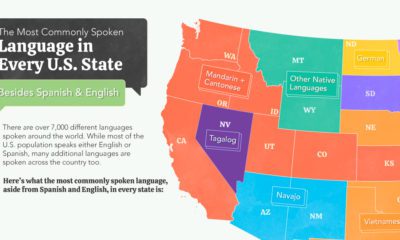
The Most Commonly Spoken Language in Every U.S. State (Besides English and Spanish)
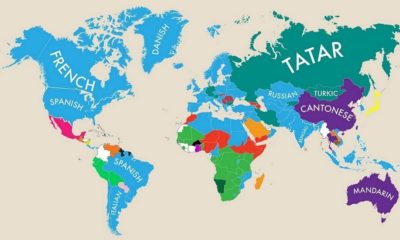
Mapped: Second Primary Languages Around the World
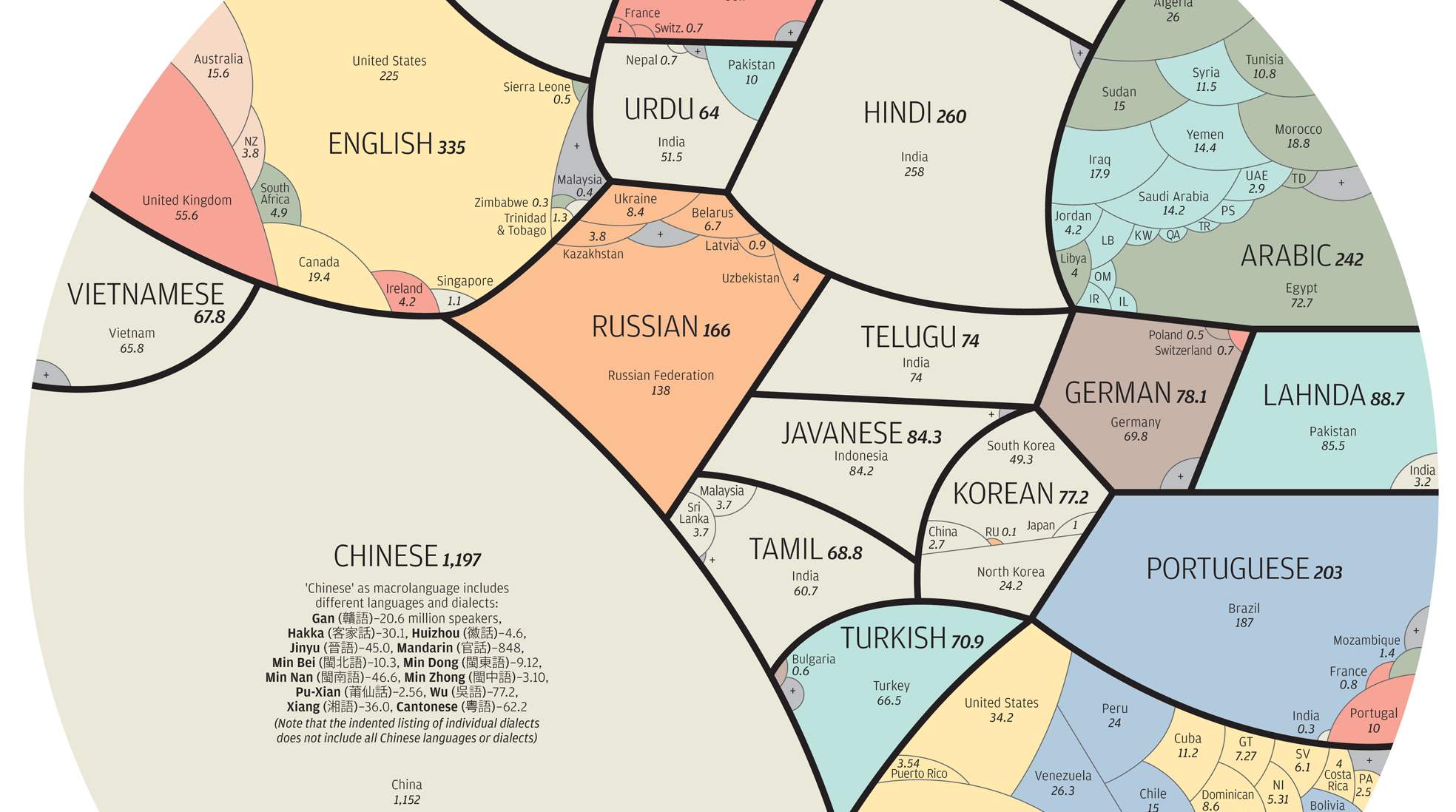
All World Languages in One Visualization
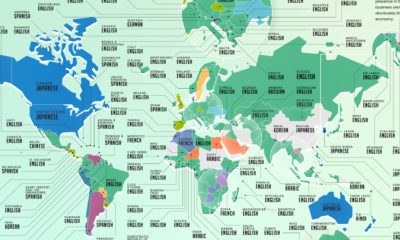
This is the Language Each Country Wants to Learn the Most
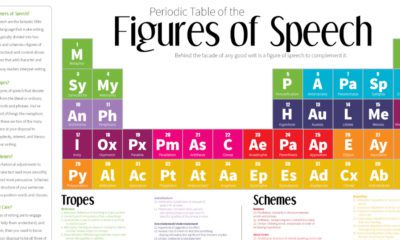
Figures of Speech: 40 Ways to Improve your Writing
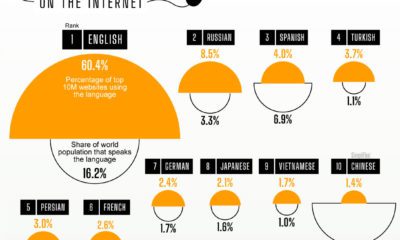
Visualizing the Most Used Languages on the Internet
Datastream
AWS: Powering the Internet and Amazon’s Profits
Amazon is best known for its sprawling ecommerce empire, but three-quarters of the company’s profits actually come from cloud computing.
The Briefing
AWS: Powering the Internet and Amazon’s Profits
The Amazon growth story has been a remarkable one so far.
Most of these sales come from their retail and ecommerce operations, which the company has come to be known for. However, on the bottom line, the source of profit paints a completely different picture. That’s because 74% of Amazon’s operating profit comes from Amazon Web Services (AWS).
Here’s a closer look at the financials around Amazon and AWS:
| Year | AWS Operating Profit ($B) | Total Operating Profit ($B) | AWS % of Operating Profit | Revenue ($B) |
|---|---|---|---|---|
| 2021 | $18.5 | $24.8 | 74% | $469.8 |
| 2020 | $13.5 | $22.9 | 59% | $386.1 |
| 2019 | $9.2 | $14.5 | 63% | $280.5 |
| 2018 | $7.2 | $12.4 | 58% | $232.8 |
Ultimately, the data suggests that the cloud business has been, and possibly will always remain, a higher margin business and consistent profit center in comparison to ecommerce and the physical distribution of goods.
A Glance at AWS
AWS is Amazon’s cloud computing service that provides the critical infrastructure for an assortment of applications like data storage and networking. With this, they help fuel over a million organizations including businesses like Twitter and Netflix and even both the U.S. and Canadian Federal Governments.
Here are some other notable entities and the monthly payments they’ve made towards AWS:
| AWS Customer | Monthly Payments ($M) |
|---|---|
| Netflix | $19 |
| Twitch | $15 |
| $13 | |
| $11 | |
| Turner Broadcasting | $10 |
| BBC | $9 |
| Baidu | $9 |
| ESPN | $8 |
| Adobe | $8 |
| $7 |
Based on these monthly figures from 2020, AWS collects $1.3 billion in sales a year just from these 10 customers, while raking in $62 billion of revenue overall. Moreover, this makes them the leader in the competitive cloud market.
In an industry worth an excess of $180 billion, Amazon’s 33% market share position exceeds both Google and Microsoft (Azure) combined. Their market share also surpasses the bottom six shown on the chart combined, who are formidable tech giants in their own right.
The Future of AWS?
AWS has been a cash cow for years and there have even been rumors of an Amazon split up, where AWS would spin off as its own entity. It’s believed by some that if the cloud segment of the business separates, it will be seen as a pure play on the cloud industry and will be awarded a higher valuation multiple by the market.
One thing is for sure, from the perspective of profits, Amazon could be better be described as a cloud company, with an ecommerce business on the side.
Where does this data come from?
Source: Amazon SEC Filings
Notes: Operating profit is the profit from the business before the deduction of non-operating expenses like interest and taxes.
Datastream
Ranked: These Are 10 of the World’s Least Affordable Housing Markets
An analysis of 90+ major cities reveals which ones are the least affordable housing markets based on their price-to-income ratio.
The Briefing
These Are 10 of the World’s Least Affordable Housing Markets
It’s become increasingly difficult for middle-class families to purchase a home over the last few years—and the global pandemic has only made things worse.
According to Demographia’s 2022 Housing Affordability Report, the number of housing markets around the world deemed “severely unaffordable” increased by 60% compared to 2019 (prior to the pandemic).
This graphic looks at some of the least affordable housing markets across the globe, relative to median household income. The report covers 92 different cities in eight nations: Australia, Canada, China, Ireland, New Zealand, Singapore, the United Kingdom, and the United States.
The Least Affordable Housing Markets
Before diving in, it’s worth outlining the methodology used in this report, to help explain what’s classified as a severely unaffordable housing market.
To calculate affordability, a city’s median housing price and divided by its median household income. From there, a city is given a score:
All the cities on this graphic are classified as severely unaffordable—and, for the 12th year in a row, Hong Kong takes the top spot as the world’s most unaffordable housing market, with a score of 23.2.
| Housing Market | Nation | Score |
|---|---|---|
| Hong Kong | 🇭🇰 Hong Kong (SAR) | 23.2 |
| Sydney, NSW | 🇦🇺 Australia | 15.3 |
| Vancouver, BC | 🇨🇦 Canada | 13.3 |
| San Jose, CA | 🇺🇸 U.S. | 12.6 |
| Melbourne, VIC | 🇦🇺 Australia | 12.1 |
| Honolulu, HI | 🇺🇸 U.S. | 12.0 |
| San Francisco, CA | 🇺🇸 U.S. | 11.8 |
| Auckland, AUK | 🇳🇿 New Zealand | 11.2 |
| Los Angeles, CA | 🇺🇸 U.S. | 10.7 |
| Toronto, ON | 🇨🇦 Canada | 10.5 |
One reason for Hong Kong’s steep housing costs is its lack of supply, partly due to its lack of residential zoning—which only accounts for 7% of the region’s zoned land. For context, 75% of New York City’s land area is dedicated to residential housing.
Sydney moved up one spot this year, making it the second most expensive city to purchase a home on the list, with a score of 15.3. Besides Hong Kong, no other city has scored this high in the last 18 years this report has been released.
There are several theories for Sydney’s soaring housing rates, but industry expert Tom Forrest, CEO of Urban Taskforce Australia, boils it down to one fundamental issue in an interview with Australia Broker—supply isn’t keeping up with demand:
“Housing supply has been consistently not meeting demand in the Greater Sydney and across regional New South Wales…if you have supply consistently not meeting demand then the price will go up. That’s what happened and we’re seeing it in abundance.” Tom Forrest, CEO of Urban Taskforce Australia
The COVID-19 Impact
Middle-income earners were already feeling the squeeze prior to the global pandemic, but COVID-19 only exacerbated housing affordability issues.
As people began to work from home, high-income earners started to look for more spacious housing that wasn’t necessarily in the city center, driving up demand in suburban areas that were relatively affordable prior to the pandemic.
At the same time, supply chain issues and material costs impacted construction, which created a perfect storm that ultimately drove housing prices up.
But with interest rates rising and COVID-19 restrictions easing around the world, some experts are predicting a market cool down this year—at least in some parts of the world.
Where does this data come from?
What are the Most Spoken Languages in the World?
written by
George Julian
What are the most spoken languages in the world?
This question isn’t as simple as it may seem. There are a few complications that make it hard to give a precise answer:
First of all, what do you mean by spoken? Do you want to rank languages by their number of native speakers, or by how many people speak them at all, natively or non-natively? These two approaches produce very different-looking lists.
Secondly, where do you draw the boundary between a language and a dialect? How different do two “dialects” have to be before they’re considered separate languages entirely? There’s often no clear answer – and the answer you give can significantly affect a language’s position in the “most-spoken” rankings.
With that being said, it’s possible to come up with some rough rankings. Here’s the best estimate, at the time of writing, as to the most-spoken languages in the world – going by total number of speakers, not just natives.
The Top 10 Most Spoken Languages in the World
1. Mandarin Chinese (1.1 billion speakers)
Number of native speakers: 897 million
Number of non-native speakers: 193 million
Total speakers: 1.09 billion
Name in the language itself: ж™®йЂљиЇќ (Putonghua)
Language family: Sino-Tibetan
Related to: Cantonese, Tibetan, Burmese
People sometimes speak of “Chinese” as if it’s a single language. It’s actually a group of related languages, of which Mandarin Chinese is by far the biggest. It’s an official language in the People’s Republic of China, the Republic of China (Taiwan), and Singapore.
The native name for Mandarin, Putonghua, literally means “common speech”, although in Taiwan people call it Guoyu – “national language”. Historically, it was also called Guanhua – “the speech of officials”. Since Mandarin is more common in northern China, it’sВ sometimes referred to as beifanghua (еЊ—ж–№иЇќ) – “Northern Dialects”.
Mandarin is written using Chinese characters (sometimes called “Han characters”), an ancient pictorial system where each symbol represents a different word. There are two main versions – “traditional” characters, used in Taiwan, Hong Kong, and Macau, and “simplified” characters, used in China, Singapore, and Malaysia. It’s estimated that you need to learn 2,000-3,000 characters to read a newspaper – an educated Chinese person will know about 8,000!
2. English (983 million speakers)
Number of native speakers: 371 million
Number of non-native speakers: 611 million
Total number of speakers: 983 million
Language-family: Germanic, a sub-family of Indo-European.
Related to: German, Dutch, Frisian
Name in the language itself: English. But you already knew that.
Thanks to the historical dominance of the British Empire – and, more recently, the economic and cultural clout of the United States – English is well-established as the world’s lingua francaВ (if only there were other contenders for an international language), and is the second most spoken language in the world.
The name “English” comes from the “Angles”, a Germanic people who settled in Britain in the first millennium A.D.. They ultimately derived their name from Anglen, a region in northern Germany, and of course they gave their name to the area now known as England.
At its core, English is a Germanic language. Its vocabulary and sentence structure are closest to modern languages like German and Dutch. However, it’s been heavily influenced by other languages throughout its strange history. Much English vocabulary is Latin in origin, having been introduced by the French-speaking Normans who conquered Britain in the 11th century A.D.
3. Hindustani (544 million speakers)
Number of native speakers: 329 million
Number of non-natives: 215 million
Total number of speakers: 544 million
Language family: Indo-Aryan, a sub-family of Indo-European.
Related to: Bengali, Punjabi, Marathi, Kashmiri, Nepali
Name in the language itself: हिन्दुस्तानी or ہندوستانی
Hindustani is the collective name for Hindi and Urdu – two dialects of the same language. The name comes from Hindustan, a historical term for the north/north-western part of the Indian subcontinent.
Hindi is spoken across northern and central India, and is the official language of the Indian government. Urdu is primarily spoken in Pakistan. While Hindi and Urdu have differences in vocabulary and pronunciation, speakers of either language can easily communicate with each other.
A notable difference between Hindi and Urdu is that they use different writing systems. Hindi is usually written in in Devanagari script – called “देवनागरी” in the script itself. Urdu, on the other hand, is written right-to-left with a script that’s closely related to the Arabic alphabet. The name “Urdu” itself is written “Ш§ЩЏШ±ШЇЩЏЩ€”.
4. Spanish (527 million speakers)
Number of native speakers: 436 million
Number of non-native speakers: 91 million
Total number of speakers: 527 million
Language family: Romance, a sub-family of Indo-European.
Related to: French, Portuguese, Italian, Romanian
Name in the language itself: espaГ±ol or castellano
ВЎSГ seГ±or! By number of native speakers, Spanish is the second biggest language in the world (behind only Mandarin). By total speakers, it’s at number four.
The language now known as Spanish originated in the Castile region of Spain. For this reason, it’s sometimes referred to as “Castilian” – castellano in the language itself. Since then, Spanish explorers and conquistadores have spread their language all around the world. It’s spoken all across South and Central America and the Caribbean, with pockets of speakers in Southeast Asia and even Africa.
(Trivia tidbit: Equatorial Guinea is the only country in Africa to have Spanish as an official language.)
Spanish is also the second most-common language in the United States, which is home to a whopping 40 million native speakers. This makes the U.S. the second-biggest Spanish-speaking country in the world, behind only Mexico – and it’s predicted that, within our lifetimes, it’ll overtake Mexico and become the largest.
5. Arabic (422 million speakers)
Number of native speakers: 290 million
Number of non-natives: 132 million
Total number of speakers: 422 million
Language family: Semitic, a sub-family of Afro-Asiatic.
Related to: Hebrew, Amharic, and Aramaic.
Name in the language itself: العَرَبِيَّة‎‎ (al-ʻarabiyyah)
Arabic is the official language of 26 countries, although some have argued that it’s not really one language, but several.
If we leave this aside and assume that there’s a single tongue called “Arabic”, then it’s a massive language, with over 400 million speakers. It originated on the Arabian peninsula, and has since spread all across the Middle East and North Africa.
Arabic is also, of course, the language of Islam. While most Muslims are not native Arabic speakers, the language is of special importance to the world’s second-largest religion. Islam holds that God (via the angel Gabriel) literally spoke in Arabic when he dictated the Quran to Mohammed.
That was 1400 years ago, and modern Arabic dialects have changed a lot since the “Classical Arabic” of the Quran. As well as their local dialects, many Arabs also speak “Modern Standard Arabic”, an academic dialect that’s based on Classical Arabic.
6. Malay (281 million speakers)
Number of native speakers: 77 million
Number of non-natives: 204 million
Total number of speakers: 281 million
Language family: Austronesian
Related to: Javanese, Tagalog
Name in the language itself: bahasa melayu
Malay is an official language in Singapore, Brunei, Indonesia, and Malaysia. You can also hear it being spoken in parts of Thailand and the Philippines. It’s by far the largest of the Austronesian languages – a family that’s thought to have originated in Taiwan.
The area in which Malay is spoken is extremely linguistically diverse. Indonesia alone is home to more than 700 living languages! Bahasa melayu, as it’s known, has a long history in the region as a lingua franca, the language of government and trade.
Except Indonesians don’t call it bahasa melayu (Malay), they call it bahasa indonesia (Indonesian). Malaysians call it bahasa malyasia (Malaysian). These dialects are mutually intelligible, and shouldn’t be considered separate languages.
Just whatever you do, don’t call it “Bahasa”! For some reason, foreigners often call it this, but the word bahasa simply means “language”. Malay isn’t called “Bahasa” any more than Spanish is called “Idioma”. You have been warned.
7. Russian (267 million speakers)
Number of native speakers: 153 million
Number of non-natives: 113 million
Total number of speakers: 267 million
Language family: East Slavic, a sub-family of Indo-European
Related to: Ukrainian, Belarusian
Name in the language itself: СЂСѓМЃСЃСЃРєРёР№ СЏР·С‹МЃРє, (rГєsskiy yazГЅk)
The largest of the Slavic languages, Russian is the official language of four countries (Russia, Belarus, Kazakhstan, and Kyrgyzstan). It’s also widely spoken in many other countries of the former Soviet Union, and has official status in numerous sub-national territories.
Russian’s closest relatives include Ukrainian and Belarusian. The three are all descended from the language that was spoken in the medieval state of the Kievan Rus. More distantly, they’re related to other Slavic languages like Polish, Czech, Slovak, Bulgarian, and Serbo-Croat.
By number of native speakers, Russian is the biggest language in Europe. Like many of the Slavic languages, it’s written with the Cyrillic alphabet (see here for some tips on how you can learn it.)
8. Bengali (261 million speakers)
Number of native speakers: 242 million
Number of non-natives: 19 million
Total number of speakers: 261 million
Language family: Indo-Aryan, a sub-family of Indo-European.
Related to: Hindustani, Punjabi, Marathi, Kashmiri, Nepali
Name in the language itself: বাংলা (Bangla)
Sometimes known in English by its native name Bangla, Bengali is the official language of Bangladesh and of several Indian states. In fact, it’s the the second most widely spoken language in India.
Like Hindustani (mentioned above), Bengali is an Indo-Aryan language. This is a branch of the Indo-European family; other branches include the Romance and Germanic languages. In other words, Bengali and Hindustani are (believe it or not) distant cousins of English.
Bengali is written in the Bengali alphabet, sometimes known as Eastern Nagari or Bengali-Assamese script. It’s related to Tibetan script. Natively, “bengali alphabet” translates to “bangla bГґrnГґmala”. In the alphabet itself, that looks like this: বাংলা বর্ণমালা.
Bengali script is relatively unknown in the West, but it’s actually the fifth most widely-used writing system in the world. More people worldwide write in Bengali script than in Cyrillic!
9. Portuguese (229 million speakers)
Number of native speakers: 218 million
Number of non-natives: 11 million
Total number of speakers: 229 million
Language family: Romance, a sub-branch of Indo-European.
Related to: French, Spanish, Italian, Romanian
Name in the language itself: portuguГЄs
Portuguese developed from Latin and is closely related to modern Spanish. The name comes from “Portugal”, whose name in turn comes from Porto, the second-largest city in that country. But the word porto in Portuguese simply means “port”.
Someone who speaks Portuguese is called a Lusophone. This word comes from “Lusitania”, the Roman name for the area that’s now Portugal. The vast majority of Lusophones live in Brazil, which has more than twice as many Portuguese speakers than the rest of the world put together!
The Portuguese empire once stretched far and wide, from South America to Africa to as far as India and Southeast Asia. Today, Portuguese is an official language in nine countries, as well as in the Chinese territory of Macau.
Personally, I find Brazilian Portuguese to be an extremely beautiful language. That’s just one of many great reasons to learn it.
10. French (229 million speakers)
Number of native speakers: 76 million
Number of non-natives: 153 million
Total number of speakers: 229 million
Language family: Romance, a sub-branch of Indo-European.
Related to: Spanish, Portuguese, Italian, Romanian
Name in the language itself: le français
Rounding up the top 10 is French, another Romance language. It’s the official language of 28 countries, with the highest number of speakers in France, Canada, Belgium, then Switzerland (in that order). It’s also widely spoken in parts of Western and Central Africa, on several Caribbean islands, and even on the South American mainland (in the French overseas department of French Guiana.)
French is a Romance language, but over the centuries it’s taken on heavy influence from Celtic and Germanic tongues. In fact, the language (and country) are named after the Franks, a collection of tribes from the Middle Ages whose language, Frankish, was Germanic, not Romance.
Frankish is now extinct, but it’s believed to have contributed many words to modern French vocabulary. French, in turn, contributed many words to English vocabulary, largely thanks to the Norman invasion of Britain in 1066.
As well as the countries and territories that speak French today, many people worldwide speak French-based creoles – particularly in Haiti, where most of the population speak Haitian Creole as their only language. Haitian Creole is heavily influenced by French, but different enough to be considered a separate language.
5 Huge Languages That You Didn’t Realise Had So Many Speakers
Did any of the top 10 most spoken languages surprise you?
While researching this post, I spotted a few languages whose size surprised me – including some I’d never even heard of before. Let’s finish off with a quick look at some languages which don’t get much global attention, but nevertheless have a large number of speakers.
(Note that this isn’t a list of the 11th to 15th largest languages overall, although some of them are in that category.)
1. Hausa
Number of native speakers: 85 million
Number of non-natives: 65 million
Total number of speakers: 150 million
Language family: Chadic, a sub-family of Afroasiatic
Related to: Ron, Bole. More distantly: Arabic, Somali
Name in the language itself: Yaren Hausa or Harshen Hausa
Hausa just barely missed inclusion in the above list. By some estimates, it’s the 11th most spoken language worldwide – although Punjabi may be bigger (see below). By number of native speakers (85 million), Hausa is in twelfth place.
A member of the Chadic family, Hausa is the biggest language in Nigeria, and a national language of Niger. There are also many native speakers living in Chad. Across wide swathes of western and central Africa, Hausa is used as a trade language.
The Chadic languages are a sub-branch of the Afroasiatic family, meaning that Hausa is distantly related to Arabic. It’s normally written in a Latin-based alphabet called boko, although you can sometimes see it written in ajami, an alphabet that’s based on Arabic script.
2. Punjabi
Number of native speakers: 148 million
Number of non-natives: negligible
Total number of speakers: 148 million
Language family: Indo-Aryan, a sub-family of Indo-European.
Related to: Hindustani, Bengali, Marathi, Kashmiri, Nepali
Name in the language itself: аЁЄа©°аЁњаЁѕаЁ¬а©Ђ or ЩѕЩ†Ш¬Ш§ШЁЫЊ (panjabi)
Punjabi is named for the Punjab, a region in northern India and Eastern Pakistan. It has close to 150 million native speakers – more than Hausa, although by total number of speakers it’s not clear whether Hausa or Punjabi is bigger.
The most commonly spoken language in Pakistan, Punjabi is a member of the Indo-Aryan family. It’s also spoken by a wide diaspora – it’s the fourth most common language in the United Kingdom!
Punjabi, along with its fellow Indo–Aryan languages like Hindi/Urdu and Bengali, is a very distant cousin of English (All are part of the wider Indo-European language family). What makes Punjabi very unusual among its Indo-European relatives is that it’s a tonal language.
3. Telugu
Number of native speakers: 80 million
Number of non-natives: 12 million
Total number of speakers: 92 million
Language family: Dravidian
Related to: Tamil, Malayalam, Kannada
Name in the language itself: తెలుగు (Telugu)
I’ve already mentioned three South Asian languages: Hindustani, Bengali, and Punjab. Those are all from the Indo-European family. The next biggest South Asian language is Telugu, which is a Dravidian language (meaning that, unlike the first three, it has no known relation to English).
Telugu is the third most-common language in India, spoken mainly in the southeast of the country. It has about 75 million native speakers. That’s more than the population of the U.K.!
Telugu is the fifteenth most-spoken language worldwide, and has its own rather beautiful writing system. In the language itself, the alphabet is called “తెలుగు а°Іа°їа°Єа°ї” (Telugu lipi).
4. Javanese
Number of native speakers: 84 million
Number of non-natives: negligible
Total number of speakers: 84 million
Language family: Austronesian
Related to: Malay, Tagalog
Name in the language itself: basa Jawa
I covered bahasa indonesia above. But Indonesia, with 260 million people spread over more than 17,000 islands, is home to some extraordinarily diverse cultures, and has over 700 living languages.
Most Indonesians speak a local language as well as Indonesian. The most common of those local languages is Javanese, which is spoken on (you guessed it) the island of Java. More than half of Indonesia’s population lives on Java, making it the most populous island not just in Indonesia but in the entire world.
Javanese is related to Indonesian, but not super-closely; they’re very much separate languages. As the Indonesian government only recognises Indonesian as the official language, this makes Java the largest language in the world not to have official status in any country.
5. Southern Quechua
Number of native speakers: 6 million
Number of non-natives: 1 million
Total number of speakers: 7 million
Language family: Quechua
Name in the language itself: Quechua
Southern Quechua has about 7 million speakers, which means it’s not nearly as big as some of the other languages I could have included. For example, Gujarati and Malayalam have far more speakers but I’ve covered enough Indian languages already.
So what makes Southern Quechua interesting? In my mind it deserves an honourable mention, because it’s the biggest of all indigenous American languages. Sadly, the Western hemisphere isn’t nearly as linguistically diverse as it used to be, but Southern Quechua is still going strong.
Note that people often call this language simply Quechua – but, to be precise, “Quechua” is more of a language family than one specific language. “Southern Quechua” is used to refer to the largest grouping of mutually intelligible dialects in the Quechua family. Its native speakers mostly live in Peru and Bolivia.
Another honourable mention should go to GuaranГ. It has about 6 million speakers, so it’s not huge. But it has the distinction of being the only native American language to have official status in any country (specifically, Paraguay.) It’s also the only such language that’s widely spoken by a large number of non-native people – many GuaranГ-speaking Paraguayans are of European, not indigenous, descent.
There are many other languages I could include on this list – such as Sundanese (spoken by 15% of the population of Java), or Kannada, which is spoken not in the country whose name it resembles but India. (Seriously, India is huge.) This all goes to show – you’ll never run out of languages to learn!
George Julian
Content Writer, Fluent in 3 Months
George is a polyglot, linguistics nerd and travel enthusiast from the U.K. He speaks four languages and has dabbled in another five, and has been to more than forty countries. He currently lives in London.
Speaks: English, French, Spanish, German, Vietnamese, Portuguese



